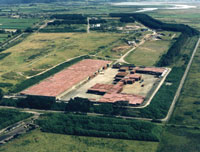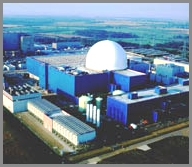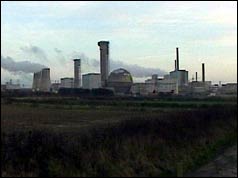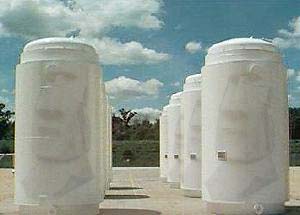 Having
done little to solve the radioactive waste problem for 50 years, a
government wishing to awake a dormant nuclear power sector appointed an
authority and a committee to provide a solution. If the public could be
assured that the past problems were on the way to being resolved, while
asserting that the improved technology of the new reactors would create
minimal waste, public perceptions would be improved and the way cleared
for the building of a new fleet of stations.
Having
done little to solve the radioactive waste problem for 50 years, a
government wishing to awake a dormant nuclear power sector appointed an
authority and a committee to provide a solution. If the public could be
assured that the past problems were on the way to being resolved, while
asserting that the improved technology of the new reactors would create
minimal waste, public perceptions would be improved and the way cleared
for the building of a new fleet of stations.
The onset of global warming presented a golden opportunity to claim that nuclear power offered carbon-free electricity generation, even though the actual fission in the reactor is the only element in the entire fuel cycle that emits no carbon dioxide. The depletion of Britain's gas (after the "dash-for-gas") also engendered a fear of the lights going out that has bolstered the nuclear lobby's spin.
The spin

Nuclear generation started in 1956 when HM Queen Elizabeth II threw
the switch for the inauguration of the UK's first nuclear power
station, Calder Hall on the Windscale site in Cumbria, since renamed
Sellafield. A year later a neighbouring weapons plutonium generating
reactor, Pile 1, caught fire, spreading a radioactive plume downwind
over the surrounding countryside. Some years later, in 1986, Chernobyl
contaminated a huge area of Belarus and Ukraine. Thus occurrences in
both the defence and civil nuclear programmes contributed to a public
perception of a brooding and latent horror waiting to threaten our wellbeing.

The parallel and interdependent defence and power generation pursuits
produce a continuous flow of radioactive waste. It's piling up – high
level waste at Sellafield, intermediate level waste on the sites where
it arises and low level waste stored at Drigg, also in Cumbria. Some of
the radioactive elements in the nuclear waste will be with mankind until
it ends.
Also nuclear power is an adjunct to the manufacture of nuclear weapons. With the need to replace the Trident nuclear deterrent, it will be essential to retain the ability to generate the plutonium needed and to maintain the skills in nuclear physics and engineering.
The twin tasks
There are two major considerations,
- the decommissioning of nuclear power stations and supporting functions on a variety of sites and
- the disposal of the radioactive waste therefrom.
During its operation the components of a reactor deteriorate due to
irradiation. Steels are embrittled and the graphite used to moderate the
reaction disintegrates. Radioactive isotopes of hydrogen, carbon, iron
and nickel are formed, which make demolition difficult. A Nuclear
Decommissioning Authority (NDA) has taken responsibility on behalf of
the government for the decommissioning of the weapons facilities and the
generating stations with their supporting plants.

When the nuclear fuel charge in a reactor is no longer creating enough
heat, i.e., it is spent, it is removed and held in a stirred and cooled
pond of water. It is still dangerously radioactive and continues to
generate heat. But the worst feature is that the fission creates highly
radioactive and long-lasting isotopes of plutonium, neptunium and
americium which remain a problem for thousands of years and with the
spent fuel comprise the high level waste. The reactor components are
classed as intermediate level waste, while clothing and used equipment
adds to the low level waste.
The nuclear waste has been the subject of studies by a Committee on
Radioactive Waste Management (CoRWM) arguing for the establishment of an
"independent body" to oversee an "implementing body"
which will deal with it. CoRWM recommends that in the interim, waste
should be securely stored on the sites where it arises, followed by a
final geological disposal.
Little having been done in the first 50 years of the nuclear era,
intensive activity on the part of both will be required over the next
120 years to decommission the shutdown Magnox power stations and the
nuclear installations. NDA has estimated the first tranche of costs as
£70 billion.
 Moreover,
the NDA strategy fails to include the costs of decommissioning a further
12 nuclear plants still operating, viz., four Magnox reactors, the seven
Advanced Gas-cooled Reactors (AGR's) and Sizewell B. The decommissioning
of these in due course will add another £15 -£20 billion to NDA's
budget, so that rumours of its task costing £100 billion in total are
probably well founded. NDA has not included in its strategy the eventual
decommissioning of a new fleet of reactors.CoRWM has declined to cost
its programme, but taking into account the need for interim measures and
the excavation of an underground final disposal, it can be construed
from the various consultation documents, that the implementation will
cost around £50 billion.
Moreover,
the NDA strategy fails to include the costs of decommissioning a further
12 nuclear plants still operating, viz., four Magnox reactors, the seven
Advanced Gas-cooled Reactors (AGR's) and Sizewell B. The decommissioning
of these in due course will add another £15 -£20 billion to NDA's
budget, so that rumours of its task costing £100 billion in total are
probably well founded. NDA has not included in its strategy the eventual
decommissioning of a new fleet of reactors.CoRWM has declined to cost
its programme, but taking into account the need for interim measures and
the excavation of an underground final disposal, it can be construed
from the various consultation documents, that the implementation will
cost around £50 billion.
CoRWM has also declined to study the waste arising from "new build". New designs of reactors are claimed to have extended operational life cycles over the present 35 years. If the operational cycles of the new types attain 60 years as claimed, decommissioning and waste management will extend well beyond the envisaged CoRWM timeline ending in 2120.
Meeting costs
The 2006 Energy Review demanded that
"Any new nuclear stations … would also meet full decommissioning costs and their full share of long-term waste management costs." (Paragraph 5.96).
As NDA and CoRWM have refrained from estimating the new build decommissioning and long-term waste management costs, it will be difficult to know what the full share will comprise that the new station builders are expected to cover. DTI have assumed that the "back-end" costs will be only 3% of the total nuclear costs and that
"only a relatively small annual contribution … to a financial reserve which grows over time" of £1/MWh would suffice.
In the NDA financial analysis, the estimated station decommissioning
costs exceed the original capital costs, reflecting the need for the
cautious handling of the radioactive components. These, together with
the CoRWM waste handling costs, will certainly exceed the 3%
"back-end" nuclear life cycle costs assumed in the Energy
Review and cycle costs around 50% would be more realistic. If the £1/MWh
is based on a mere 3%, then it will be totally inadequate. If the
operational cycle be interrupted for any reason, the annual contribution
will fail to be paid. The station builder should instead put up a
suitably-sized bond, at least equal to the capital cost of the station,
to ensure that the taxpayer does not end up with the bill.
 Requests
to NDA to complete their cost analyses have met with refusal. CoRWM
compared estimates of various options to assist in determining its
recommendations, but has not provided a figure for the total cost of its
programme, though it has estimated the additional volume of waste for
"new build". So the Energy Review team has no basis for its
assumption that the "back-end" costs are only 3% of the new
type reactor overall costs. The construction of an adequate financial
mechanism constraining developers to meet the full decommissioning and
waste management costs requires a more comprehensive analysis than has
yet been performed. Perhaps NDA and CoRWM have been asked to defer the
missing cost calculations lest their publication proves the
non-viability of nuclear power.
Requests
to NDA to complete their cost analyses have met with refusal. CoRWM
compared estimates of various options to assist in determining its
recommendations, but has not provided a figure for the total cost of its
programme, though it has estimated the additional volume of waste for
"new build". So the Energy Review team has no basis for its
assumption that the "back-end" costs are only 3% of the new
type reactor overall costs. The construction of an adequate financial
mechanism constraining developers to meet the full decommissioning and
waste management costs requires a more comprehensive analysis than has
yet been performed. Perhaps NDA and CoRWM have been asked to defer the
missing cost calculations lest their publication proves the
non-viability of nuclear power.
If a developer is to meet the full costs of decommissioning and waste
management in an acceptable financial mechanism, its scope cannot be
judged without an idea of the "new build" costs.
It has to be emphasised however that to estimate the cost of a programme
extending over more than a century is likely to be somewhat problematic.
NDA describes its burden as a "legacy"; it is enough of an
inheritance without adding to it. Future generations will deplore their
unsolicited dowry.
Timeline
In a period up to 2035, CoRWM proposes that the interim arrangements
will be defined, communities willing to accept the disposal arrangements
will be identified and site investigations and selection will take
place. The planning and construction of the repository would be affected
over the following ten years from 2035 to 2045, then followed by 65
years when the waste would be placed and a further ten years for the
closure of the repository, taking the programme up to 2120.
Assuming the energy contribution of nuclear power remains at 8% of the
UK's total energy, then around 90% of the available energy to perform
the decommissioning and waste handling tasks will be from fossil fuels.
As oil and gas supplies rapidly deplete as the century progresses, it is
highly unlikely that in 2035, when CoRWM proposes that the excavation of
the geological disposal commences, that the necessary energy will be
available.
The procurement of sufficient energy to perform the excavation of the
repository in 30 years time will prove problematic and although the
decommissioning timescale would not require it to be usable before then,
it would be better to start the excavation immediately while the diesel
needed for the machinery is still available.
Reprocessing, mixed oxide fuel and breeders
Given that the supply of raw uranium is limited, the nuclear industry
has come up with three main solutions in an attempt to secure a
longer-term future. Natural uranium is enriched to increase its
fissionable component, leaving depleted uranium as waste, so that only
around 10% of the raw uranium is burned in the reactor.
The spent nuclear fuel elements are very radioactive and have to be kept
in stirred and cooled ponds for from 5 to 25 years after removal from
the reactor. They are then cut up and dissolved in nitric acid allowing
the depleted uranium and plutonium to be separated. Some of the uranium
is returned to the enrichment plant for fuel manufacture, while the
plutonium goes to the mixed oxide plant where it is combined with
another part of the depleted uranium to make a mixed oxide fuel, MOX.
 The
UK Thermal Oxide Reprocessing Plant (THORP) and the Sellafield Mixed
Oxide Plant (SMP) are located at Sellafield on the Irish Sea. The
operation of the plants has been an unmitigated disaster. THORP is
currently closed because of a massive radioactive leak, while the MOX
plant has never met its production rate. Both plants add to the
radioactive high level waste and feature in the NDA strategy. The two
plants were to have provided some revenue to alleviate the
decommissioning costs, but both are like to be closed and will add to
the costs rather than reduce them.The long-term future of nuclear power
relied on the fast breeder reactor, which was supposed to
"breed" new fuel while generating electricity. There have been
many attempts to develop a successful one, but all have failed despite
massive investment. The high operating temperatures require special
coolants and the containment materials, such as nickel steels, are
extremely weak at the elevated temperatures. They are also embrittled by
the radiation. It is highly unlikely that a successful breeder reactor
will ever be developed.
The
UK Thermal Oxide Reprocessing Plant (THORP) and the Sellafield Mixed
Oxide Plant (SMP) are located at Sellafield on the Irish Sea. The
operation of the plants has been an unmitigated disaster. THORP is
currently closed because of a massive radioactive leak, while the MOX
plant has never met its production rate. Both plants add to the
radioactive high level waste and feature in the NDA strategy. The two
plants were to have provided some revenue to alleviate the
decommissioning costs, but both are like to be closed and will add to
the costs rather than reduce them.The long-term future of nuclear power
relied on the fast breeder reactor, which was supposed to
"breed" new fuel while generating electricity. There have been
many attempts to develop a successful one, but all have failed despite
massive investment. The high operating temperatures require special
coolants and the containment materials, such as nickel steels, are
extremely weak at the elevated temperatures. They are also embrittled by
the radiation. It is highly unlikely that a successful breeder reactor
will ever be developed.
Once-through operation
Nuclear power is therefore destined to
- run out of economically mined uranium and
- meanwhile will continue to add to the accumulating waste.

For comparison, in the USA reprocessing has been banned and the spent
fuel from over 100 reactors languishes in ponds awaiting its transfer to
dry storage casks, which are stored in guarded open yards, until the
promised repository is built. Meanwhile the ponds are practically full
and are dependent on a secure supply of electricity to prevent them
evaporating, uncovering the highly radioactive spent fuel, then drying
out and catching fire.
In the UK the spent fuel comprising the high level waste, reactor
components as intermediate level waste and copious quantities of low
level waste such as clothing and process equipment mounts up. The
deployment of the NDA strategy relies on bids from the private sector
for its decommissioning contracts. The adoption of the CoRWM
recommendations awaits a government decision.
If the UK nuclear lobby succeeds in its aims, the "new build"
will remain as a "once-through" operation and the waste stream
will be little diminished by reprocessing and supplies of MOX.
Uranium is first taken from the earth, enriched to make it fissionable,
then by its fission it creates long-enduring radioactive new elements
and may end up under the earth once again, where its new deadly nature
will hopefully be retained. If during this centuries' long process it is
allowed to escape, it will spread its deadly radiation over the earth
instead of being put under it. If disturbed after a few thousand years
it will still menace future generations.
Rip van Winkel wakes

The fabulous Rip van Winkel slept for 20 years. My Rip is human
awareness, lulled to sleep by promises of cheap power when the first
nuclear electricity left Calder Hall by Royal Command in 1956. If van
Winkel wakes up in the 22nd Century after 200 years, what will he see?
Will there be any nuclear power stations running? Or, will mounds of
earth covering former nuclear stations be evident? Will the nuclear
waste be safely treated and put underground? Or, did the fossil fuels
run out before the CoRWM recommendations could be carried out? Did some
of the spent fuel ponds run dry, contaminating lands? Did sense prevail
and nuclear power was abandoned before the problems became totally
insurmountable?
What sort of UK lifestyle remains? Was global warming avoided by Kyoto
2? Is most of what was the UK under water? Or, did the carboniferous
fuels run out before the climate "tipping point" was exceeded?
What proportion of the world's population at the beginning of the 21st
Century survives?
What a nightmare he had. I share it.